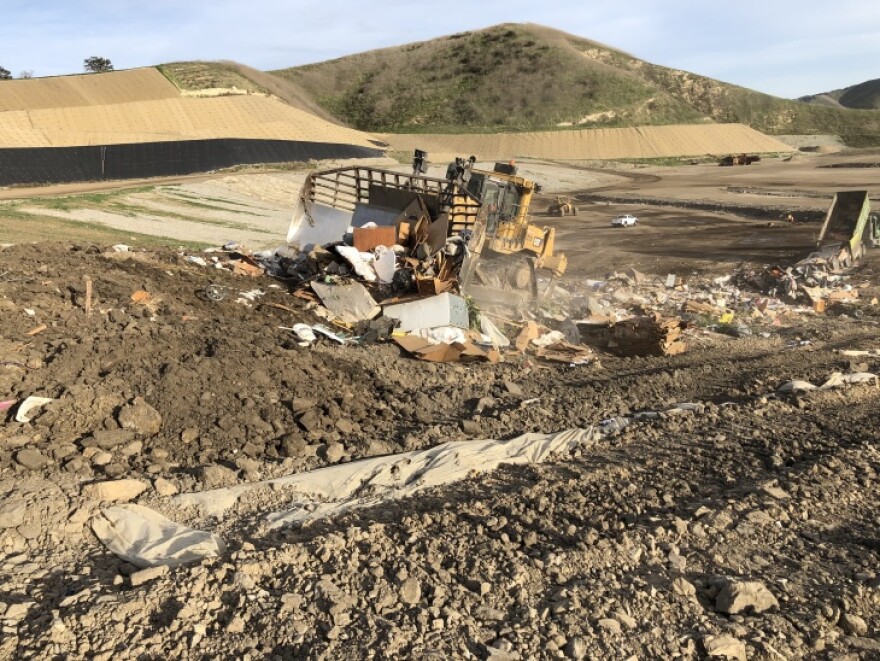This story is free to read because readers choose to support LAist. If you find value in independent local reporting, make a donation to power our newsroom today.
What Happened To Your Recyclables During The Pandemic?

Our news is free on LAist. To make sure you get our coverage: Sign up for our daily coronavirus newsletter. To support our nonprofit public service journalism: Donate now.
As Angelenos stayed home beginning in March, our trash piled up.
Normally, businesses generate more garbage than residents. But with schools and most businesses closed, the ratio reversed.
"What we're seeing is a shift," said Coby Skye, assistant deputy director for L.A. County Public Works. "There's more people now staying at home, so tonnages at home are increasing ... and we're seeing a similar decrease in tonnages from the commercial sector as some of the non-essential businesses have closed."
Skye oversees garbage hauling contracts for the 27 L.A. County Sanitation Districts that serve unincorporated areas and many cities that are smaller than Los Angeles.
The extra trash came from people eating and cooking more at home, getting grab-and-go meals from schools and takeout food from local restaurants.
There was also the "Amazon effect": with so many stores closed, people bought more online and all those cardboard boxes and packaging materials were filling up our trash and recycling bins.

The City of Los Angeles saw the same thing. Comparing this pandemic April with the same month last year, single-family home garbage went up 11 percent while the volume of commercial trash fell 24 percent.
Homes were putting out so much trash, Los Angeles city began offering "free refills" on trash bins. You could stand by your full bin on collection day, see it emptied into the city truck, then add in your extra trash to get it immediately hauled away.
OVERFLOWING BINS, CLOSED RECYCLING PLANTS
But just as household garbage and recycling bins were overflowing, a lot of our places for processing recycled bottles, cans and plastics were closing.
Twelve of the 29 plants that sort recyclables for the Los Angeles County Sanitation Districts reduced their operations or shut down entirely on March 19 when county public health officials issued stay-home orders.
Companies that operate the sorting plants made the decisions for worker safety.
While there are some automated recycling centers, most recycling is identified and hand-sorted by workers, who search through many items that have no resale or re-use value. This habit of including trash that is unlikely to be recycled is known, derisively, as "wish-cycling."
"They actually have the staff on lines very close to one another, picking out the recyclables and separating them from different commodities," Skye said.
DON'T MISS ANY L.A. CORONAVIRUS NEWS
Get our daily newsletters for the latest on COVID-19 and other top local headlines.
Terms of Use and Privacy Policy
One of the two big recycling places serving the city of Los Angeles also closed, severely reducing the capacity to process cans, bottles and plastics.
The portion of L.A. south of Mulholland Drive continued to have a materials recovery plant open to take recyclables. But the one serving homes to the north, including the San Fernando Valley, closed for several weeks.
Even when it reopened, its capacity was limited -- and that reduced the amount of recycling that could be done.
But there were still thousands of tons of cans and bottles that needed someplace to go.
Turns out there's plenty of room in the landfills. And in a pinch, that's where they headed.
"We went on a day-to-day decision-making on whether we would landfill recyclables," said Los Angeles City Sanitation General Manager Enríque Zaldívar.
About half the materials that were sorted by residents for recycling outside the city ended up in local landfills, said Bryan Langpap, spokesman for the sanitation districts.

MAINTAINING HARD-WON HABITS
The city was upfront in its messaging that some recycling loads were going straight to the landfill, Zaldívar said. But the message may have been lost amid more pressing news during the early months of the pandemic.
So why didn't they tell us to just put our recyclables in the same bin as our garbage?
Zaldívar said the city didn't want to break the hard-won habit of recycling.
"That has taken 25 years to build. We know that that investment cannot be squandered by one day's decision to say, wholesale, [we] will go to landfill now," he said.
Today, with new work rules and protections to help keep recycling workers from getting infected from the items they handle, most of the big sorting plants for recyclables are back online.
And the trash trend has begun to reverse. More businesses are opening, and some people are able to return to work.
Garbage is being sent to landfills; recyclables are again being sorted and baled for sale or reuse.
Meanwhile, recycling habits haven't changed. Because while pandemics are temporary, recycling is forever.








